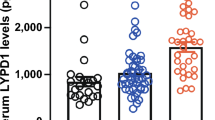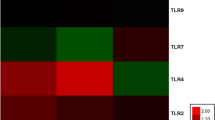Abstract
The objective of this study is to assess toll-like receptor-9 (TLR9) expression in CD3-positive T lymphocytes and CD19-positive B lymphocytes in systemic sclerosis (SSc) patients and to study their relation to the extent of skin fibrosis, disease characteristics, and severity as well as the functional status. Fifty-five female SSc patients and 30 matched controls were included. Skin thickness was scored according to the modified Rodnan skin score (mRss). The severity of major organ involvement was assessed using the Medsger severity score (MSS). Scleroderma health assessment questionnaire (SHAQ) was measured to evaluate patients’ functional status. Expression of TLR9 in CD3-positive T lymphocytes and CD19-positive B lymphocytes was studied using flow cytometry. The mean age of the patients was 40.5 ± 9.1 years, and their disease duration was 6.7 ± 3.3 years. There were 21 (38.2%) with diffuse (dcSSc) and 34 (61.8%) with limited cutaneous (lcSSc) subtypes. There was a significant increase in the expression of TLR9/CD3 and TLR9/CD19 in the SSc patients (44.9 ± 18.1 and 24.1 ± 9.6) compared to that in the control (1.4 ± 0.97 and 1.3 ± 0.94; p < 0.0001 for both, respectively) being higher in those with dcSSc. TLR9/CD3 expression was significantly increased in SSc patients with arthralgia/arthritis and digital resorption compared to those without. The TLR9/CD3 significantly correlated with the mRss and MSS (r = 0.37, p = 0.006 and r = 0.31, p = 0.02; respectively). Both the TLR9/CD3 and TLR9/CD19 expressions were significantly correlating (r = 0.53, p < 0.0001). On regression analysis, only TLR9/CD3 was a significant risk factor of the mRss and MSS (β = 0.43, p = 0.009 and β = 0.33, p = 0.015, respectively). TLR9, especially TLR9/CD3, is highly expressed in SSc patients particularly those with dcSSc subtype and could form a potential marker for skin fibrosis and disease severity.

Similar content being viewed by others
References
Farina A, Cirone M, York M, Lenna S, Padilla C, Mclaughlin S et al (2014) Epstein-Barr virus infection induces aberrant TLR activation pathway and fibroblast-myofibroblast conversion in scleroderma. J Investig Dermatol 134(4):954–964
Gianchecchi E, Fierabracci A (2015) Gene/environment interactions in the pathogenesis of autoimmunity: new insights on the role of toll-like receptors. Autoimmun Rev 14(11):971–983
Santegoets KCM, van Bon L, van den Berg WB, Wenink MH, Radstake TRDJ (2011) Toll-like receptors in rheumatic diseases: are we paying a high price for our defense against bugs? FEBS Lett 585(23):3660–3666
Bryant CE, Gay NJ, Heymans S, Sacre S, Schaefer L, Midwood KS (2015) Advances in toll-like receptor biology: modes of activation by diverse stimuli. Crit Rev Biochem Mol Biol 50(5):359–379
Trujillo G, Meneghin A, Flaherty KR, Sholl LM, Myers JL, Kazerooni EA et al (2010) TLR9 differentiates rapidly from slowly progressing forms of idiopathic pulmonary fibrosis. Sci Transl Med 2(57):57ra82
Liu Y, Yin H, Zhao M, Lu Q (2014) TLR2 and TLR4 in autoimmune diseases: a comprehensive review. Clin Rev Allergy Immunol 47(2):136–147
Takahashi T, Asano Y, Ichimura Y, Toyama T, Taniguchi T, Noda S et al (2015) Amelioration of tissue fibrosis by toll-like receptor 4 knockout in murine models of systemic sclerosis. Arthritis Rheumatol 67(1):254–265
Yoshizaki A, Iwata Y, Komura K, Ogawa F, Hara T, Muroi E et al (2008) CD19 regulates skin and lung fibrosis via toll-like receptor signaling in a model of bleomycin-induced scleroderma. Am J Pathol 172(6):1650–1663
Chockalingam A, Brooks JC, Cameron JL, Blum LK, Leifer CA (2009) TLR9 traffics through the Golgi complex to localize to endolysosomes and respond to CpG DNA. Immunol Cell Biol 87(3):209–217
Fang F, Marangoni RG, Zhou X, Yang Y, Ye B, Shangguang A et al (2016) Toll-like receptor 9 signaling is augmented in systemic sclerosis and elicits transforming growth factor beta-dependent fibroblast activation. Arthritis Rheumatol 68(8):1989–2002
Mavropoulos A, Simopoulou T, Varna A, Liaskos C, Katsiari CG, Bogdanos DP et al (2016) Breg cells are numerically decreased and functionally impaired in patients with systemic sclerosis. Arthritis Rheumatol 68(2):494–504
van Bon L, Popa C, Huijbens R, Vonk M, York M, Simms R et al (2010) Distinct evolution of TLR-mediated dendritic cell cytokine secretion in patients with limited and diffuse cutaneous systemic sclerosis. Ann Rheum Dis 69(8):1539–1547
Hoogen F, Khanna D, Fransen J, Johnson SR, Baron M, Tyndall A et al (2013) Classification criteria for systemic sclerosis: an American College of Rheumatology/European League against Rheumatism collaborative initiative. Arthritis Rheumatol 65(11):2737–2747
LeRoy EC, Black C, Fleischmajer R, Jablonska S, Krieg T, Medsger TAJ et al (1988) Scleroderma (systemic sclerosis): classification, subsets and pathogenesis. J Rheumatol 15(2):202–205
Clements P, Lachenbruch P, Siebold J, White B, Weiner S, Martin R et al (1995) Inter and intraobserver variability of total skin thickness score (modified Rodnan TSS) in systemic sclerosis. J Rheumatol 22(7):1281–1285
Medsger TAJ, Bombardieri S, Czirjak L, Scorza R, Della Rossa A, Bencivelli W (2003) Assessment of disease severity and prognosis. Clin Exp Rheumatol 21(3 Suppl 29):S42–S46
Steen VD, Medsger TAJ (1997) The value of the health assessment questionnaire and special patient-generated scales to demonstrate change in systemic sclerosis patients over time. Arthritis Rheum 40(11):1984–1991
O’Reilly S (2017) Toll like receptors in systemic sclerosis: an emerging target. Immunol Lett. https://doi.org/10.1016/j.imlet.2017.09.001
Allanore Y, Simms R, Distler O, Trojanowska M, Pope J, Denton CP et al (2015) Systemic sclerosis. Nat Rev 1:15002
Mogensen TH (2009) Pathogen recognition and inflammatory signaling in innate immune defenses. Clin Microbiol Rev 22(2):240–273 Table of Contents
Bhattacharyya S, Varga J (2015) Emerging roles of innate immune signaling and toll-like receptors in fibrosis and systemic sclerosis. Curr Rheumatol Rep 17(1):474
Yoshizaki A, Taniguchi T, Saigusa R, Fukasawa T, Ebata S, Numajiri H et al (2016) Nucleosome in patients with systemic sclerosis: possible association with immunological abnormalities via abnormal activation of T and B cells. Ann Rheum Dis 75(10):1858–1865
van Bon L, Cossu M, Scharstuhl A, Pennings BWC, Vonk MC, Vreman HJ et al (2016) Low heme oxygenase-1 levels in patients with systemic sclerosis are associated with an altered toll-like receptor response: another role for CXCL4? Rheumatology (Oxford) 55(11):2066–2073
Ciechomska M, Cant R, Finnigan J, van Laar JM, O’Reilly S (2013) Role of toll-like receptors in systemic sclerosis. Expert Rev Mol Med 15:e9
Song IJ, Yang YM, Inokuchi-Shimizu S, Roh YS, Yang L, Seki E (2017) The contribution of toll-like receptor signaling to the development of liver fibrosis and cancer in hepatocyte-specific TAK1-deleted mice. Int J Cancer. https://doi.org/10.1002/ijc.31029
Watanabe A, Hashmi A, Gomes DA, Town T, Badou A, Flavell RA et al (2007) Apoptotic hepatocyte DNA inhibits hepatic stellate cell chemotaxis via toll-like receptor 9. Hepatology 46(5):1509–1518
Sacre SM, Drexler SK, Foxwell BM (2005) Toll-like receptors and rheumatoid arthritis: is there a connection?. In: O’Neill LAJ, Brint E (eds) Toll-like Receptors in Inflammation. Birkhauser, Basel, p 19–40
Tamaki Y, Takakubo Y, Hirayama T, Konttinen YT, Goodman SB, Yamakawa M et al (2011) Expression of toll-like receptors and their signaling pathways in rheumatoid synovitis. J Rheumatol 38(5):810–820
Etem EO, Elyas H, Ozgocmen S, Yildirim A, Godekmerdan A (2011) The investigation of toll-like receptor 3, 9 and 10 gene polymorphisms in Turkish rheumatoid arthritis patients. Rheumatol Int 31(10):1369–1374
Lacerte P, Brunet A, Egarnes B, Duchêne B, Brown JP, Gosselin J (2016) Overexpression of TLR2 and TLR9 on monocyte subsets of active rheumatoid arthritis patients contributes to enhance responsiveness to TLR agonists. Arthritis Res Ther 18(1):10
Sun S, Rao NL, Venable J, Thurmond R, Karlsson L (2007) TLR7/9 antagonists as therapeutics for immune-mediated inflammatory disorders. Inflamm Allergy Drug Targets 6(4):223–235
Fullard N, O’Reilly S (2015) Role of innate immune system in systemic sclerosis. Semin Immunopathol 37(5):511–517
Author information
Authors and Affiliations
Corresponding author
Ethics declarations
The study conforms to the 1995 Helsinki declaration and was approved by Cairo University Hospitals’ ethical committee. Informed consent was obtained from all patients.
Disclosures
None.
Rights and permissions
About this article
Cite this article
Gheita, T.A., Sayed, S., Azkalany, G.S. et al. Toll-like receptor 9 in systemic sclerosis patients: relation to modified Rodnan skin score, disease severity, and functional status. Clin Rheumatol 37, 757–763 (2018). https://doi.org/10.1007/s10067-017-3880-6
Received:
Revised:
Accepted:
Published:
Issue Date:
DOI: https://doi.org/10.1007/s10067-017-3880-6




